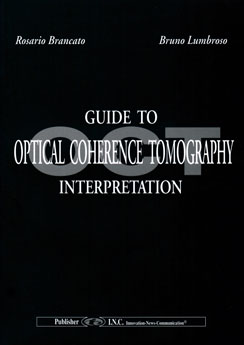B.Lumbroso, R.Brancato
Con la collaborazione di: P. Carpineto, S. Catalano, A. Pascarella, L. Pierro, G. Ripandelli, M. Rispoli, C. Scassa
I.N.C. (Innovation-News-Communication) editore, copiright 2003.
ISBN 88-86193-38-6
Optical coherence tomography (OCT) is a diagnostic technique that was introduced into clinical practice in 1997. In recent years it has become increasingly widely utilized, especiaily among retinal specialists. It has also proven useful in the diagnosis and management of glaucoma and reiated diseases. Cumulative experience and technical improvements, especiaily in the latest generation of OCT instruments, have led to a favorable consensus, even among practitioners of general ophthalmology.
The information about retinal abnormalities that OCT provides (such as intraretinal edema, retinal pigment epithelium (RPE) detachment, intraretinal and subretinal neovascular changes, vitreoretinal traction, etc.) has made this new tomographic technique increasingly useful for diagnostic purposes. OCT also serves as a complement to the angiographic examinations performed in the study of many retinal pathologies.
This short handbook, supplemented by simple illustrations, attempts to describe a logicai procedure for image interpretation, through the application of the well-known Cartesian approach consisting of analysis fcllowed by synthesis.
We hope that this work of ours will be received favorably by our colleagues.
Pubblicato in lingua italiana ed inglese


itstitle
excerptsa
ordering enclomiphene generic no prescription
how to buy enclomiphene buy online canada
kamagra prescrire eu medicament pharmacie
je veux une prescription kamagra
purchase androxal usa sales
buy cheap androxal price usa
order dutasteride purchase prescription
get dutasteride cheap usa
order flexeril cyclobenzaprine price australia
order flexeril cyclobenzaprine buy singapore
generic gabapentin usa pharmacy
compare generic gabapentin prices
how to buy fildena cheap now
No perscription fildena
get itraconazole cheap in canada
generic itraconazole over the counter usa
buying avodart uk cheapest
discount avodart purchase from canada
ordering staxyn price prescription
staxyn cash on delivery
buying xifaxan buy uk no prescription
online order xifaxan generic compare
online order rifaximin generic is it safe
order rifaximin american pharmacy
koupit kamagra bez
kamagra comprar kamagra generico